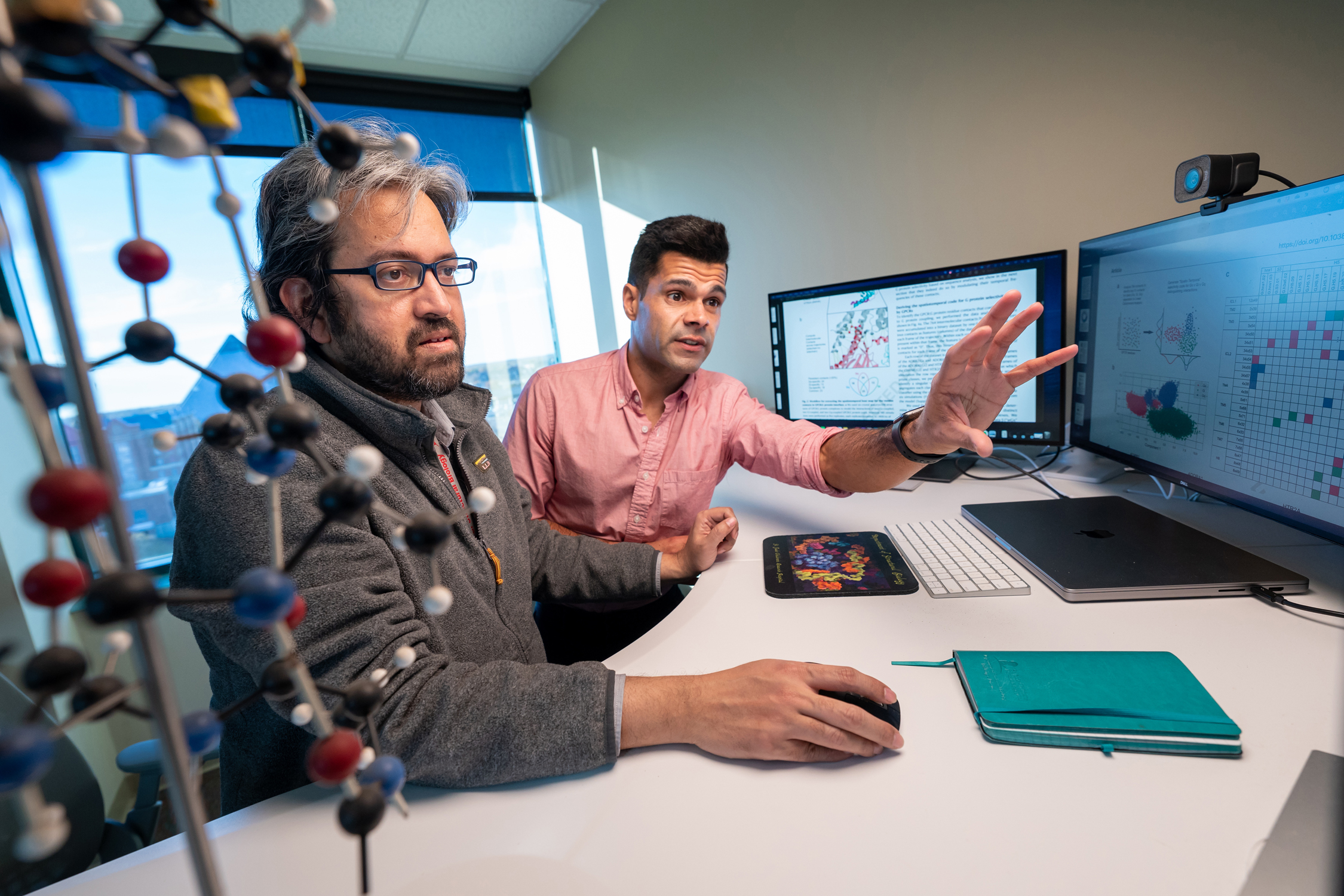(Memphis, Tenn.—December 5, 2022) Scientists at St. Jude Children’s Research Hospital used molecular dynamics simulations to study how G-protein coupled receptors (GPCRs) couple with G-proteins. Their work revealed that the complex spatial (location) and temporal (duration) nature of intermolecular contacts between GPCRs and G-proteins is governed through a common central interface, with selective interactions on the periphery of that interface. The study, published today in Nature Communications, is important for pharmaceutical research because G-protein selectivity is essential in determining how cells respond to drugs.
One-third of all Food and Drug Administration–approved drugs target GPCRs. GPCRs are membrane proteins found on the surface of cells, which transmit signals inside the cell through their interaction (coupling) with G-proteins. There are four major G-protein families that direct different cellular responses. Some GPCRs couple with just one type of G-protein, while others can couple with several G-proteins. The researchers wanted to better understand what determines the selectivity or promiscuity of G-protein interactions with GPCRs.
“This work points to a remarkable structure-function relationship paradigm that different GPCR family members have explored and exploited to make the receptor either extremely selective or extremely promiscuous,” said co-corresponding author M. Madan Babu, Ph.D., St. Jude Center of Excellence in Data Driven Discovery director and Department of Structural Biology member.
Molecular dynamics reveals more
Molecular dynamics is a computer simulation approach for analyzing the movements of atoms and molecules. The technique was useful for capturing the interactions of GPCRs and G-proteins through the lenses of space and time. These interactions can be difficult to capture with conventional technologies to look at protein structures like cryo-EM and X-ray crystallography, which provide static snapshots. Due to the complex and convoluted nature of GPCR interactions, they lend themselves to studies with techniques that probe their dynamics.
“Molecular dynamics is a technique that allows you to take established models of protein complexes, based off cryo-EM and X-ray crystallography structures, and apply real-world physics to simulate how these proteins may dynamically ‘breathe-in’ around that conformational space,” said first-author Manbir Sandhu, Ph.D., St. Jude Department of Structural Biology.
“I enjoy looking at biology and identifying how information is transmitted across different scales of time and space,” Sandhu said. “Our work brings us closer to charting how ligand binding leads to the correct residues being available on the interface to couple to the appropriate G-protein. It is information that’s transmitted over nanometer distances in microseconds of time in the cell, but which is encoded in the sequence of specific receptor families. Thus, this information has also been transmitted over a huge swath of evolutionary time.”
‘Promiscuous’ GPCRs still have potential
The researchers found that GPCRs maintain contact with G-proteins through a common central interface. Selectivity comes from G-protein specific contacts at the periphery of that interface.
Understanding G-protein selectivity is of tremendous interest for drug development as well as for interpreting drug responses. Some GPCRs are promiscuous, they have many G-protein partners they can bind to in the cell. There are drugs that function by limiting the number of G-protein partners or other intracellular partners that a receptor can couple with. This phenomenon, called bias, is a major area of pharmaceutical research.
The primary problem with targeting a promiscuous GPCR is that they are more likely to generate a greater variety of responses to a drug, and thus have more side effects. Promiscuity can thus make such receptors unattractive targets for drug development. The refined understanding of receptors and intermolecular contacts presented in the team’s work may renew interest in drug development around these harder to effectively target GPCRs.
“Using large-scale data analysis techniques to investigate the largest superfamily of drug target proteins, the GPCRs, we have identified the rules or ‘QR code’ for coupling of these proteins,” said co-corresponding author Nagarajan Vaidehi, Ph.D., Department of Computational and Quantitative Medicine chair at City of Hope, a cancer research and treatment organization. “Understanding these rules of engagement will enable the design of cleaner drugs for cancer, diabetes and neurodegenerative diseases with minimal side effects.”
Authors and funding
Other authors of the study are Aaron Cho, Yoon Namkung and Stephane Laporte, Research Institute of the McGill University Health Centre; Ning Ma, Elizaveta Mukhaleva, Sangbae Lee, Soumadwip Ghosh and John Lee, Beckman Research Institute of the City of Hope; and David Gloriam, University of Copenhagen.
The study was supported by grants from the National Institutes of Health National Institute of General Medical Sciences (R01-GM117923 and R01-GM097261), the UK Medical Research Council (MC_U105185859), the Lundbeck Foundation (R313-2019-526), the Novo Nordisk Foundation (NNF17OC003126), the Canadian Institute of Health Research (PJT-162368 and PJT-173504) and ALSAC, the fundraising and awareness organization of St. Jude.
St. Jude Children’s Research Hospital
St. Jude Children’s Research Hospital is leading the way the world understands, treats and cures childhood cancer, sickle cell disease and other life-threatening disorders. It is the only National Cancer Institute-designated Comprehensive Cancer Center devoted solely to children. Treatments developed at St. Jude have helped push the overall childhood cancer survival rate from 20% to 80% since the hospital opened 60 years ago. St. Jude freely shares the breakthroughs it makes, and every child saved at St. Jude means doctors and scientists worldwide can use that knowledge to save thousands more children. Families never receive a bill from St. Jude for treatment, travel, housing and food — so families can focus on helping their child live. To learn more, visit stjude.org or follow St. Jude on social media at @stjuderesearch.
